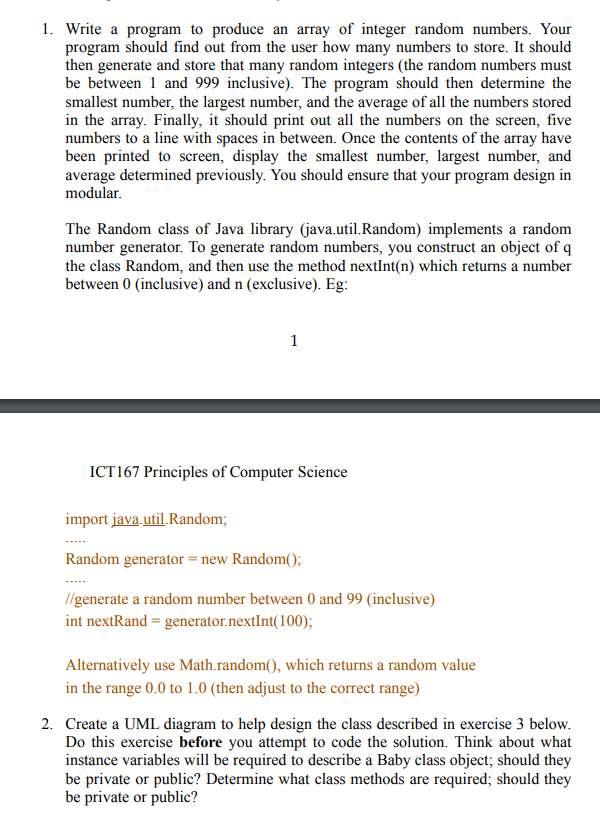

1. Write a program to produce an array of integer random numbers. Your program should find out from the user how many numbers to store. It should then generate and store that many random integers (the random numbers must be between 1 and 999 inclusive). The program should then determine the smallest number, the largest number, and the average of all the numbers stored in the array. Finally, it should print out all the numbers on the screen, five numbers to a line with spaces in between. Once the contents of the array have been printed to screen, display the smallest number, largest number, and average determined previously. You should ensure that your program design in modular. The Random class of Java library (java.util. Random) implements a random number generator. To generate random numbers, you construct an object of a the class Random, and then use the method nextInt(n) which returns a number between 0 (inclusive) and n (exclusive). Eg: 1 ICT167 Principles of Computer Science import java.util.Random; Random generator = new Random(); // generate a random number between 0 and 99 (inclusive) int nextRand = generator.nextInt(100); Alternatively use Math.random(), which returns a random value in the range 0.0 to 1.0 (then adjust to the correct range) 2. Create a UML diagram to help design the class described in exercise 3 below. Do this exercise before you attempt to code the solution. Think about what instance variables will be required to describe a Baby class object; should they be private or public? Determine what class methods are required; should they be private or public? 3. Write Java code for a Baby class. A Baby has a name of type String and an age of type integer. Supply two constructors: one will be the default constructor, that just sets default values for the name and age; the second constructor will take two parameters, a string to set the name and an integer to set the age. Also, supply methods for setting the name, setting the age, getting the name and getting the age. The class should not contain I/O methods; input of values to the instance variables must be done with a set method or constructor, output of values from the instance variables must be done with get methods. The set method for the name instance variable should ensure that the input is not empty or contain whitespaces (otherwise set a default value). The set method for the age instance variable should validate the input to be between 1 and 4 inclusive (otherwise set a default value). Give Java code for an equals method for the Baby class. Babies count as being the same (i.e. equal) if their names and their ages are exactly identical (names should not be case sensitive). The method will take a Baby type parameter and use the calling object (thus comparing these two objects via name and age); it should return Boolean - true or false as appropriate. Remember, if comparing Strings, you must use String comparison methods. 4. Test your Baby class by writing a client program which uses an array to store information about 4 babies. That is, each of the four elements of the array must store a Baby object. If you have an array for baby names and another array for baby ages, then you have missed the point of the exercise and therefore not met the requirement of this exercise








